The mess and joy of creativity
Amy Davidson '02 Latta is sharing the art of hand lettering and the path to creative discovery, one lesson at a time. We asked her about her newest book and her advice on all things creative.
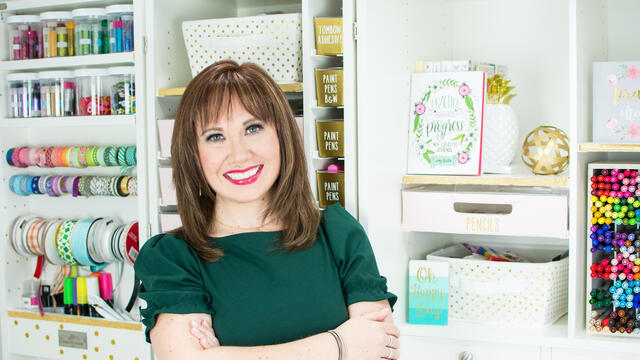
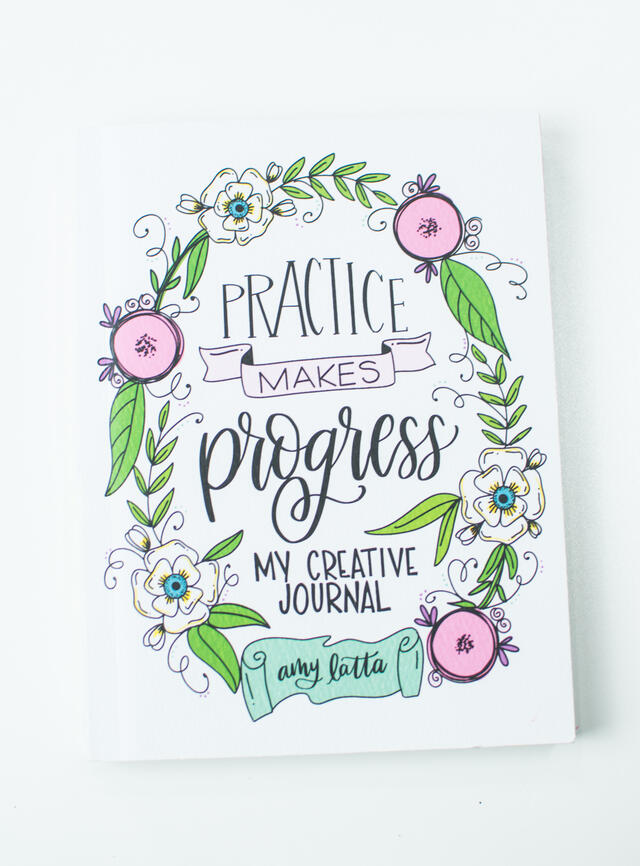
In February, alumna Amy Davidson ’02 Latta published her sixth book, a guide to creativity titled “Practice Makes Progress: My Creative Journal.” An English major with a minor in Education, Latta worked as a public school teacher, a dance instructor, and a creative blogger before publishing her first book in 2017. She now teaches workshops with brands like Michaels and Tombow and shares projects on a variety of TV channels, including Good Day PA, WBAL-TV 11, Midday Maryland, and Hallmark Home & Family.
Latta spoke with us about her creative career, how to discover the courage to make art, and finding silver linings during the COVID-19 pandemic.
A Conversation with Amy Latta
- What will someone discover when they open your newest book, “Practice Makes Progress: My Creative Journal”?
-
My hope is that readers who open this book will be inspired to discover, explore, and embrace their creativity in whatever ways they enjoy the most. After writing a series of five instructional hand lettering workbooks, I wanted to switch gears and publish something that would be relevant for everyone, not just those who are interested in handwriting. I wanted to write a book that appealed to those who don’t feel creative at all, as well as those who already consider themselves makers and crafters, and to encourage them along their creative journeys.
Since this book is designed to help readers express creativity in a huge variety of ways, it follows a different format than my previous books, which are filled with projects and skill-based tutorials. Instead, “Practice Makes Progress” is a guided journal built around twenty-five different quotes about creativity. Each chapter is based on one of these quotes and contains a brief reflection along with multiple prompts for readers to complete. Some exercises can be done right there on the page, like filling out a chart, circling responses, or doing a little sketch. Others ask readers to jump off the page and go express their thoughts on the topic by doing whatever they love; anything from woodworking to painting to quilting to writing a poem.
- Early in “Practice Makes Progress: My Creative Journal,” you ask readers to address the role of fear and courage in their artmaking process. Why start there?
-
In my experience, one of the biggest things that holds people back from creating is a fear of failure. We worry that we won’t be able to create something “good,” or that it won’t be as beautiful as the next person’s project. We fear that we’re just not that creative and we won’t know what to do. Once we get over that obstacle, there’s no limit to what we can create! When we stop fearing what others will think and let ourselves try something new, the sky is the limit!
-
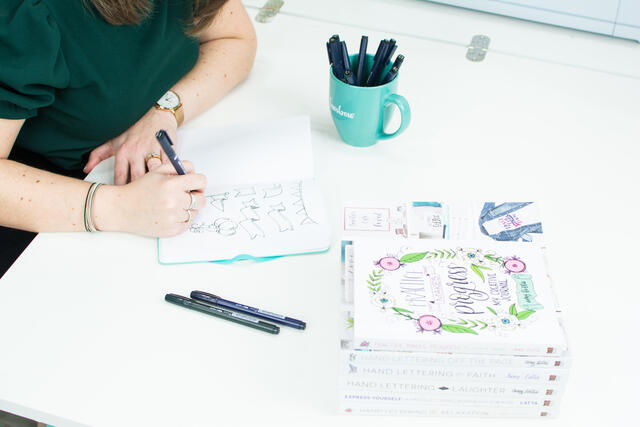
-
The most difficult part of this project was probably making sure the prompts in the journal were relevant for all readers, no matter where they are in their creative journey. I didn’t want to alienate or overwhelm folks who are just getting started, or who don’t feel particularly artistic. At the same time, I wanted to offer something that would also be helpful for those who have been crafting and making art for a long time. I tried to think about what some of the universal stumbling blocks are for creatives and address those things. For example, I tackle the problem of unfinished projects, the mess that creativity can make, the fear of failure or rejection, and the joy that can come from creating for others. Hopefully, the majority of the quotes I chose are relatable for all readers, and the project suggestions are open ended enough that they appeal to everyone.
- What advice would you give to someone who is interested in learning a new art form, but wouldn’t consider themselves a creative person?
-
We are all creative in our own unique ways. I like to remind people that the definition of an artist is not limited to Bob Ross with his paint palette, making happy little trees. Art and creativity have a scope far beyond what we might traditionally think. For example, my dad spent his career building homes, sidewalks, and fireplaces. He would tell you that he’s not artistic at all, but if you saw one of the fireplaces he made using stacked stone, you’d instantly recognize it as a masterpiece. Creativity takes all different forms. You can find it in the kitchen or on the construction site just as easily as in the art studio. It’s in a silly song we sing or the way we apply our makeup. It’s in the way we arrange our furniture or combine ingredients to perfect a sauce. We all possess it, it’s up to us how we put it to use.
If you want to learn a new art form, there are tons of resources: online videos, library books, local classes and workshops, or even just asking someone who knows how to do it. Just dive in and see what happens!
- "You won’t regret pursuing a career that allows you to do something you love every day, but you will definitely regret choosing a job that feels like work."
- COVID-19 has been challenging to many artists. Have your artistic and business practices changed since the pandemic began?
-
During the height of the pandemic, when we were all in lockdown, my art was integral to helping me process the situation. I kept a pandemic journal and recorded my thoughts and feelings as well as the things that were going on around me so that I would have a record of it all. My sons and I also took advantage of the opportunity to do creative acts of kindness, like painting and hiding colorful rocks around our neighborhood for people to find while they were walking, and making sidewalk chalk art for our neighbors.
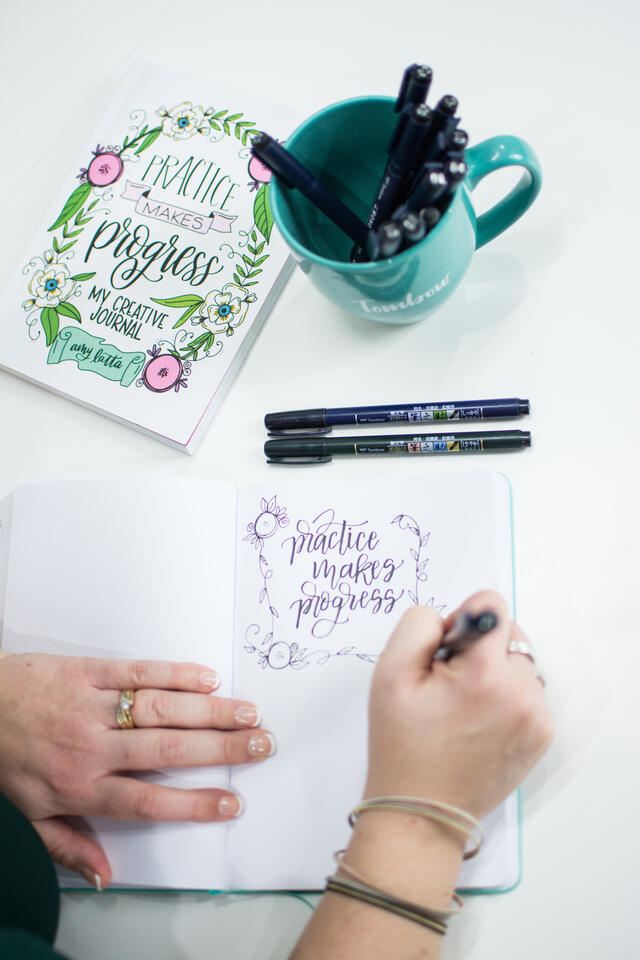
As things settled down a bit and we shifted back into a semi-normal reality, I found that there were actually some silver linings for my business. Learning to do everything virtually via Zoom and other platforms opened up new opportunities for me to teach people I couldn’t see in person.
Previously, my workshops were local, unless I traveled somewhere like the Pinners Conference, but now I can teach and host workshops all over the country, thanks to technology. I led multiple national workshops with Michaels Stores and Tombow, and taught classes for people as far away as France and England. Many television studios are now open to virtual segments, so while I was already filming (in person) with Good Day PA, I am also now appearing regularly on lifestyle shows all over the country including Today in Nashville, Great Day Live Tampa, SA Live!, Hello Iowa, Arizona Midday, AM Northwest, Studio 5, and more. It’s been a ton of fun being able to share creativity all over the country from my own little studio in the basement.
- As a working creative, how do you balance life demands with moments where you can find creativity and discovery?
-
The thing about creativity is that it doesn’t follow a schedule. I find that it usually strikes whenever it chooses, not when I have a ton of free time. So, I jot down an idea or take a photo of whatever inspired me and put it aside until I’m done with the dishes or whatever other responsibility I’m handling at the moment. Then, when the kids are in school or it’s the weekend and I have free time, I close myself in my craft studio and play!
- As a McDaniel alumna, what advice would you give to current students who are interested in a creative career?
-
One of the reasons I think people tend to shy away from creative careers is the “starving artist” stereotype. People in our lives tell us that we’ll never make a living that way, but the reality is that there are tons of job opportunities out there in today’s world. The job I do, as a craft and lifestyle blogger, didn’t even exist when I was in college, but I’m making a career of it and bringing in more income than I did when I was a teacher in the public school system. Don’t let the stereotype hold you back. You won’t regret pursuing a career that allows you to do something you love every day, but you will definitely regret choosing a job that feels like work.
- After completing their “Practice Makes Progress” journal, which of your workbooks should someone pick up?
-
All five of the other books will teach you different hand lettering skills. Many people tend to gravitate to “Hand Lettering for Relaxation,” but it really depends on what kind of projects you want to create. “Express Yourself” is designed to teach lettering to kids ages 6-17; “Hand Lettering for Laughter” will teach you to letter funny/sarcastic quotes; and “Hand Lettering for Faith” is about Bible journaling. If you want to learn to make craft projects with your lettering, like wooden wall signs, decorative chalkboards, flowerpots, phone cases, apparel, and more, you’ll love “Hand Lettering Off the Page.” Personally, I think they’re all pretty fabulous…but I may be a little biased.
Purchase your copy of “Practice Makes Progress: My Creative Journal," at Amy Latta Creations.
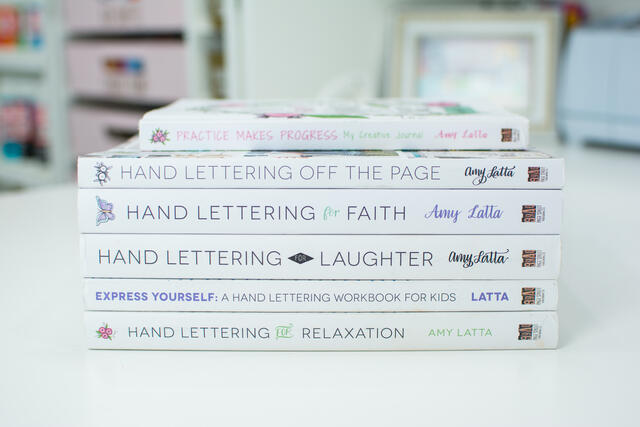
*please note, the book launch party scheduled for Saturday, March 12, 2022 has been canceled due to inclement weather.